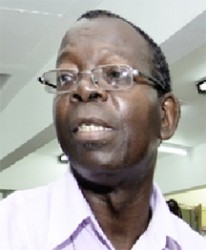While the $500 million EU-funded Doppler Radar system here has failed to deliver the goods, its counterparts in Barbados and Trinidad are producing streams of data and frequent dangerous-weather warnings.
Quite visible is the local radar’s inability to play a meaningful role in informing Guyanese of adverse weather conditions in advance. This was made clear on November 27th when Regions 2, 3, 4, 5, 6, 7 and 10 experienced exceptionally heavy rainfall that no one, including officials at Guyana’s Meteorological Office, seemed to know was coming. The result was that tens of thousands of Guyanese were caught off guard as floods abounded.
It resulted in Head of the Presidential Secretariat, Dr Roger Luncheon stating on November 29 that the “Hydromet failed us”. Agriculture Minister Dr Leslie Ramsammy had later said that the weather experienced was the result of a high pressure system off Bermuda pushing the Inter-Tropical Convergence Zone closer to Guyana.

Even if Guyana’s Meteorological Office was aware that the system was headed to Guyana, there are very few ways the information gathered via Doppler is made available to the general public. Data generated from the radar is available to the general public via www.hydromet.gov.gy, but the site is complicated to navigate, and requires some knowledge of how to read radar imaging. Data gathered from the Doppler is also used formulate the weather forecast broadcast on NCN’s radio and television broadcasts. This method of disseminating the information though, limits its scope as members of the public would have to be tuned into NCN to benefit from the information.
Stabroek News has also been told that Guyanese are welcome to call the weather station at Timehri at any time for an update on the weather but questions asked to random persons on the street revealed that very few people are aware of this option. As things stand, Ramsammy has said, “what the Doppler has been placed there for is to say that presently in this environment where the airport is, because this is for airport visibility and telling where the airplanes what kind of weather we have.”
He further said that for more to be done with the data generated by Doppler, other technology, which requires more money, would have to be added.

But checks by Stabroek News with two other Caribbean countries which are using the Doppler Radar shows that there is much more that Guyana can be doing with the resources it currently possesses. It is also worth noting that while Stabroek News was able to conduct interviews with regional meteorologists, those in charge of the hydromet office here do not entertain media queries.
Chief Meteorologist at the Trinidad and Tobago Meteorological Office Shakeer Baig, in an interview with Stabroek News from Port-of-Spain last week, explained that they have successfully used Doppler to warn citizens of oncoming flashfloods on several occasions. He first explained that Doppler was a welcome development for Trinidad’s Met Office, particularly since it offers the ability to do “now casting.”
He said that previously they depended heavily on satellite imagery, which is generated out of the U.S. and which is 30 or sometimes 45 minutes old. The problem this posed is that if the Met Officer wanted to monitor a thunderstorm “you can miss it altogether if it has a 30 minute lifecycle,” he shared.
But, with Doppler, “you can see high resolution images over an area within a ten-minute radius. This gives the ability to observe the onset, duration, and dissipation of the storm,” he continued. Baig said that Doppler offers meteorologists the opportunity to observe wind direction and strength, and also enables them to say if an area is going to see stormy weather or downbursts based on the clouds.
Using Doppler to observe the characteristics of clouds, he said, the Met Office is able to have an idea of how much perceptible water a cloud contains, and therefore how much rain a given area is likely to experience.
Using this information, the T&T Met Office can, and has issued flashflood warnings before the rain even begins. Being able to issue such warnings in advance, he explained, is very important since Trinidad is so prone to flashfloods.
And, the avenues through which these warnings are disseminated are numerous. Baig said that warnings are broadcast via television and radio, as well as the Met Office’s website. He also said that the office has a Facebook page and a twitter account which are used to reach out to persons who may have missed radio, or television broadcasts. He also mentioned that the Met Office is working with telecommunications companies in an effort to start sending warnings via text messages.
None of these platforms are available for the dissemination of weather information here.
Meanwhile, the Meteorological Office in Barbados says that they use Doppler to identify and give warnings of tropical storms before they make their mark on the island. Senior Meteorologist at Barbados Weather, Clairmonte Williams told Stabroek News in an interview last week that by the time a tropical storm gets close enough to the island for it to feel the effects, Doppler would have already picked it up and warnings would have already been issued.
Despite this ability though, he said that the radar is used primarily to identify current rainfall, and is therefore a short-term forecasting tool – able to read weather conditions six to less than twenty four hours out.
Williams said that the information generated by the Doppler Radar is used in the preparation of weather forecasts, which are broadcast by radio and television and are available online at Barbadosweather.org.
Guyana, Barbados, Trinidad and Tobago and Belize, through a EU-funded €13 million project, adopted the Doppler Radar as they sought to improve their individual weather forecasting capacities, as well as their ability to effectively monitor weather phenomena in the region via the creation of an electronic composite of the Caribbean.
On October 7, 2009, Stabroek News had reported then Agriculture Minister Robert Persaud as saying that the “Doppler Weather Radar” is a crucial milestone in the modernization of the Hydrometeorological Service.” He noted that the Ministry was envisaging that as it expanded, the Hydromet Service would centralize its entire operations to Hyde Park, Timehri.
Persaud said that the new generation of radar would complement the current hydrometeorological monitoring network and said that “it would provide continuous real-time coverage out to 400 kilometers from Timehri.”
The Minister noted that the Doppler weather radar would allow forecasters to: “increase precision in defining the areas where severe weather is likely to form, Identify the characteristic patterns indicating a high probability of severe thunderstorms, Improve accuracy in forecasting the time, intensity and location of heavy precipitation and to provide timely and accurate information on approaching severe weather systems.”
According to him, “planners and policy makers in agriculture, water resources management, engineering, aviation, mining, sea defences and the public at large would also be provided with much needed real time weather information which will make a timely impact on security, civil defence and national development.”








